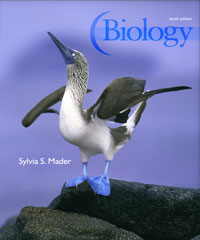Biology (Mader), 10th EditionChapter 29:
Vertebrate EvolutionLearning OutcomesAfter studying this chapter, you should be able to accomplish the following outcomes. The Chordates - Outline the four characteristics of chordates.
- Describe and give examples of the two nonvertebrate chordates.
- List the seven derived characteristics used to form the chordate phylogenetic tree.
The Vertebrates- Describe the four features in addition to the chordate characteristics which characterize the vertebrates.
- Discuss the evolution of vertebrates.
The Fishes- Give examples of the jawless fishes, living and extinct.
- State the characteristics of the jawed fishes.
- Distinguish between the cartilaginous fishes and the bony fishes, giving examples of each.
The Amphibians- List the major characteristics of amphibians.
- Discuss the evolution of amphibians.
- Use examples to demonstrate the diversity of living amphibians.
The Reptiles- State the major characteristics of reptiles.
- Explain why the amniotes are considered a paraphyletic group.
- Discuss the evolution of the major groups of reptiles.
- Use examples to demonstrate the diversity of living reptiles.
- Outline the major characteristics of birds and explain how they aid in flight.
- Describe the medicinal uses of vertebrates.
The Mammals- State the major characteristics of mammals.
- Discuss the evolution of the major mammalian groups.
- Distinguish between the major groups of mammals and give examples of each group.
 | 




